Lab’s ‘Body & Sold’ humanizes cold, hard stats about childhood prostitution
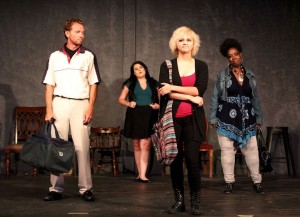 When most people read that nearly 300,000 children are forced into prostitution each year, they shake their head in bewilderment. It’s a shocking statistic, but human trafficking and childhood prostitution is an anonymous problem, right? You’ve probably never had a child or family member run away and chances are you don’t know anyone else who has either. Sure, it happens. But it
When most people read that nearly 300,000 children are forced into prostitution each year, they shake their head in bewilderment. It’s a shocking statistic, but human trafficking and childhood prostitution is an anonymous problem, right? You’ve probably never had a child or family member run away and chances are you don’t know anyone else who has either. Sure, it happens. But it 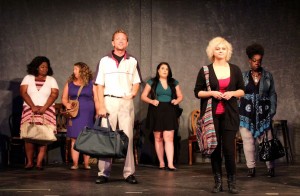 happens to other people – even if some of them live in our town, our county or someplace else right here in Southwest Florida.
happens to other people – even if some of them live in our town, our county or someplace else right here in Southwest Florida.
That’s precisely whey Deborah Lake Fortson wrote Body & Sold. And thanks to the foresight of Annette Trossbach and her Laboratory Theater play selection committee, three local audiences will have the opportunity this 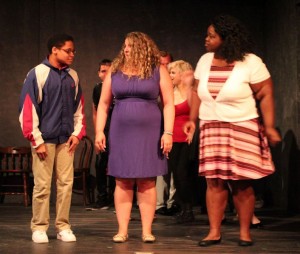 weekend to experience this growing family-based problem in a way that will forever change the way they look at the victims of this horrific reality.
weekend to experience this growing family-based problem in a way that will forever change the way they look at the victims of this horrific reality.
Fortson does this by introducing her audiences to six girls and two boys who share unsettling stories about their exploitation. Fiction writers live by the adage “show, don’t tell.” But it’s not Fortson’s intent to entertain or even educate and inform. She wants her audiences to step into 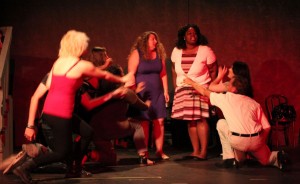 her characters’ sandals, sneakers and shoes – to see what they’ve seen and feel all that they’ve felt, experienced and endured. And so she has her characters stride to the edge of the stage, look the audience squarely in the eyes, and recount what’s happened to them through a series of fragmented monologues and
her characters’ sandals, sneakers and shoes – to see what they’ve seen and feel all that they’ve felt, experienced and endured. And so she has her characters stride to the edge of the stage, look the audience squarely in the eyes, and recount what’s happened to them through a series of fragmented monologues and 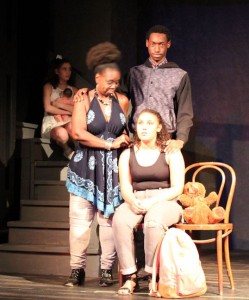 soliloquys.
soliloquys.
In the hands of a lesser talent, that might come across as preachy or even boring. But Fortson doesn’t have her characters present their stories one at a time. Instead, one character begins a tale, which is then picked up and amplified by the others in much the same way that eight people who’ve just witnessed a harrowing car wreck might talk over one another, providing their own slant on what just transpired. At times, the characters talk in unison. On occasion, all eight yell, scream or shout together like the chorus in a Greek tragedy from the quill of Euripedes or Aeschylus.
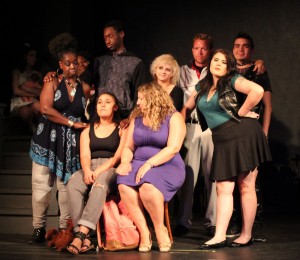 The effect is powerful. It keeps the audience off-balance which, in turn, lowers their defenses and makes them more receptive to the emotions underlying the characters’ words.
The effect is powerful. It keeps the audience off-balance which, in turn, lowers their defenses and makes them more receptive to the emotions underlying the characters’ words.
Fortson pulls no punches. Right from the jump, she addresses the elephant in the theater. Many people believe that the victims of human trafficking and childhood prostitution deserve their fate. They’re deviants, druggies and gang-bangers who run away and get their comeuppance.
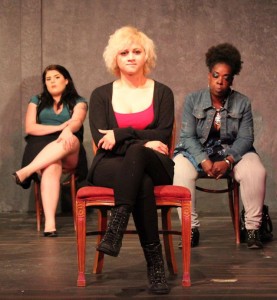 Nothing could be farther from the truth.
Nothing could be farther from the truth.
The six girls and two boys we meet in Body & Sold aren’t anything like that. They’re kids who are stuck in dysfunctional families where they’re unheard, unloved and largely unwanted. The boys are both gay, and their parents can’t abide by their sexual orientation. A couple of the girls are being sexually abused – by a parent, a stepdad or their mother’s boyfriend. “When she found out I’d had sex, she treated me like I had the plague,” laments yet another. They couldn’t stay. And so they left.
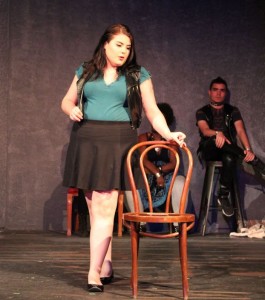 It isn’t long before they encounter that stranger who offers them the three things they crave most in life – safety, acceptance and love. But it’s an illusion, a fiction spun by a soulless opportunist bent on manipulating them for his own profit and other purposes. Before long, they find themselves ensnared in a nightmare world of prostitution, bondage and violence – at the hands of their “protector” and his customers and friends.
It isn’t long before they encounter that stranger who offers them the three things they crave most in life – safety, acceptance and love. But it’s an illusion, a fiction spun by a soulless opportunist bent on manipulating them for his own profit and other purposes. Before long, they find themselves ensnared in a nightmare world of prostitution, bondage and violence – at the hands of their “protector” and his customers and friends.
In the play, all eight eventually break free. (That’s not always the case.) But with little or no education, job training or support network, providing for themselves is a 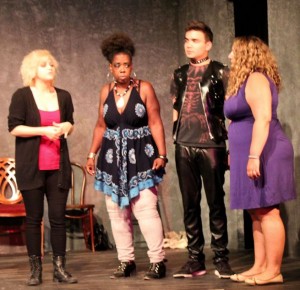 formidable task.
formidable task.
There’s something else, though, that stands in the way of them ever being able to lead and enjoy a normal life. Each of them was damaged before they ran away. After being betrayed, dehumanized and reduced to a chattel on the order of a pack horse or mule, they’re battered and broken, suffering all the symptoms of post-traumatic stress disorder, not to mention substance abuse and, in one case, HIV disease.
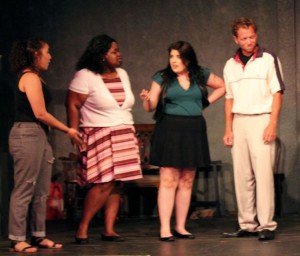 But what emerges from the flotsam and jetsam of their shattered lives is that little girl or boy who’s been hiding deep inside. The victims of human trafficking and childhood prostitution were and are just kids. Oh, they may now have the body of an adult. They may project a hardened demeanor, an emotional armor that’s virtually impossible to penetrate even by a trained psychotherapist. But they still have childlike needs and desires because those needs and desires were never met.
But what emerges from the flotsam and jetsam of their shattered lives is that little girl or boy who’s been hiding deep inside. The victims of human trafficking and childhood prostitution were and are just kids. Oh, they may now have the body of an adult. They may project a hardened demeanor, an emotional armor that’s virtually impossible to penetrate even by a trained psychotherapist. But they still have childlike needs and desires because those needs and desires were never met.
B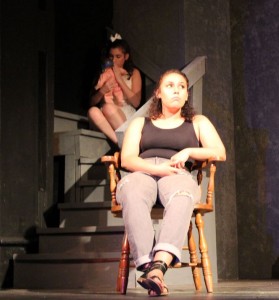 ody & Sold is not an easy play to because of the weighty topics that it embraces. It’s not an easy play to perform either. Director Kathleen Moye is to be commended for her work in assembling and drilling a young cast of varying experience through emotion-packed, difficult dialogue replete with innumerable verbal and visual cues. But the cast itself deserves high praise and compliments for a job well done. They not only made their characters’ stories their own, they identified with each other’s trial and tribulations to such a degree that it felt as if you were eavesdropping on a support
ody & Sold is not an easy play to because of the weighty topics that it embraces. It’s not an easy play to perform either. Director Kathleen Moye is to be commended for her work in assembling and drilling a young cast of varying experience through emotion-packed, difficult dialogue replete with innumerable verbal and visual cues. But the cast itself deserves high praise and compliments for a job well done. They not only made their characters’ stories their own, they identified with each other’s trial and tribulations to such a degree that it felt as if you were eavesdropping on a support 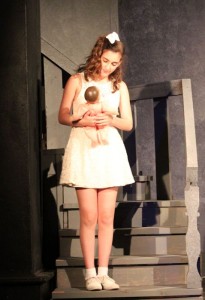 group of real people sharing their heartfelt and heartrending experiences in an effort to gain some perspective, healing and closure.
group of real people sharing their heartfelt and heartrending experiences in an effort to gain some perspective, healing and closure.
In the end, though, Body & Sold is not about closure. It’s about heightening awareness, sensitizing people and communities to a problem that’s not easily solved, and formulating strategies for protecting at-risk youngsters from the ever-present danger of sexual predators.
And that’s why The Lab will follow each performance with a panel discussion and audience talk-back with professionals working in the trenches to combat this problem 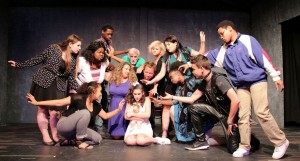 right here in our own community. Which gives them the chance to address the play’s only shortcoming – and that’s the substitution of chat rooms and social media for the bus station as the place where current-day predators connect with disgruntled children looking for love,
right here in our own community. Which gives them the chance to address the play’s only shortcoming – and that’s the substitution of chat rooms and social media for the bus station as the place where current-day predators connect with disgruntled children looking for love, 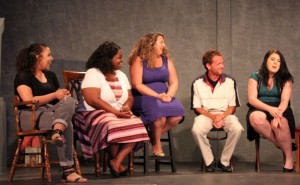 acceptance and protection in all the wrong places.
acceptance and protection in all the wrong places.
May 5, 2017.
RELATED POSTS.
- Stories told by ‘Body & Sold’ happening every day in Southwest Florida
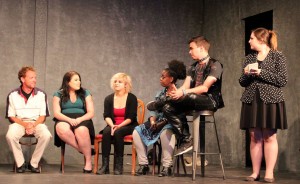 Lab Theater’s ‘Body & Sold’ focuses attention on epidemic of human trafficking
Lab Theater’s ‘Body & Sold’ focuses attention on epidemic of human trafficking- ‘Body & Sold’ play dates, times and ticket info
- Meet ‘Body & Sold’ director Kathleen Moye
- Cantrella Canady part of 12-member ‘Body & Sold’ cast
- Rosie DeLeon leaves the balcony for the boards in
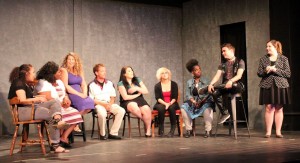 ‘Body & Sold’
‘Body & Sold’ - Patrick Erhardt part of 12-member ‘Body & Sold’ cast
- John D. Staly returns to The Lab in ‘Body & Sold’
- Justin Blake Larsche part of 12-member ‘Body & Sold’ cast














 Tom Hall is both an amateur artist and aspiring novelist who writes art quest thrillers. He is in the final stages of completing his debut novel titled "Art Detective," a story that fictionalizes the discovery of the fabled billion-dollar Impressionist collection of Parisian art dealer Josse Bernheim-Jeune, thought by many to have perished during World War II when the collection's hiding place, Castle de Rastignac in southern France, was destroyed by the Wehrmacht in reprisal for attacks made by members of the Resistance operating in the area. A former tax attorney, Tom holds a bachelor's degree as well as both a juris doctorate and masters of laws in taxation from the University of Florida. Tom lives in Estero, Florida with his fiancee, Connie, and their four cats.
Tom Hall is both an amateur artist and aspiring novelist who writes art quest thrillers. He is in the final stages of completing his debut novel titled "Art Detective," a story that fictionalizes the discovery of the fabled billion-dollar Impressionist collection of Parisian art dealer Josse Bernheim-Jeune, thought by many to have perished during World War II when the collection's hiding place, Castle de Rastignac in southern France, was destroyed by the Wehrmacht in reprisal for attacks made by members of the Resistance operating in the area. A former tax attorney, Tom holds a bachelor's degree as well as both a juris doctorate and masters of laws in taxation from the University of Florida. Tom lives in Estero, Florida with his fiancee, Connie, and their four cats.